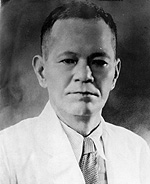|
 Okinawan
emigration to the Philippines cannot be discussed without mentioning
the astonishing achievements of Kozo Oshiro. He traveled to the
Philippines as an emigration director at the young age of 23 after
being recommended for the job by Kyuzo Toyama, who was born and
grew up in the same village. At the time Oshiro was studying at
the Tokyo Imperial University, but he left his education unfinished
and began his work with emigration. Okinawan
emigration to the Philippines cannot be discussed without mentioning
the astonishing achievements of Kozo Oshiro. He traveled to the
Philippines as an emigration director at the young age of 23 after
being recommended for the job by Kyuzo Toyama, who was born and
grew up in the same village. At the time Oshiro was studying at
the Tokyo Imperial University, but he left his education unfinished
and began his work with emigration.
Oshiro's birthplace was Kin Village, and his family was wealthy with a long and distinguished history. He was a good student and met Toyama at Kin Elementary School - Toyama was not only his teacher, but also his mentor. Oshiro became greatly interested in overseas emigration in his teens and his passion for emigration research was clearly evident.
On February 20, 1904 Oshiro departed for Manila, Philippines from Kobe. In April of the same year, 111 Okinawan emigrants departed from Naha. He then spent the rest of his life, a total of 31 years, in the Philippines until 1935, when he died from disease in a hotel in Davao.
His first job in Manila was road construction in Penget. After its completion, he led 100 or so Okinawan emigrants in moving to Davao on Mindanao Island. There he established the "Ota Commercial Corporation" with Kyozaburo Ota, garnering success with a Manila hemp plantation. He continued to invite Okinawan emigrants while vice-president of the company and dedicated his entire life to the development of Davao. His contributions were so significant that a location in Davao, Bagocero, bears his name as a tribute. He also contributed to the invention of the dynamo-applied hemp-grounding machine.
Oshiro played a key role in the establishment of the Okinawa Kenjinkai of Davao (Okinawan Association) and the Davao Nihonjinkai (Japanese Association) as well. His efforts were well recognized, as he became the first-ever president of the Nihonjinkai. The Okinawa Kenjinkai of Davao was established in 1916, and the Davao Nihonjinkai in 1918.
He died at the age of 54, his funeral conducted by the Nihonjinkai in Davao. He is known as the man who spent his life in an emigrated land.
|